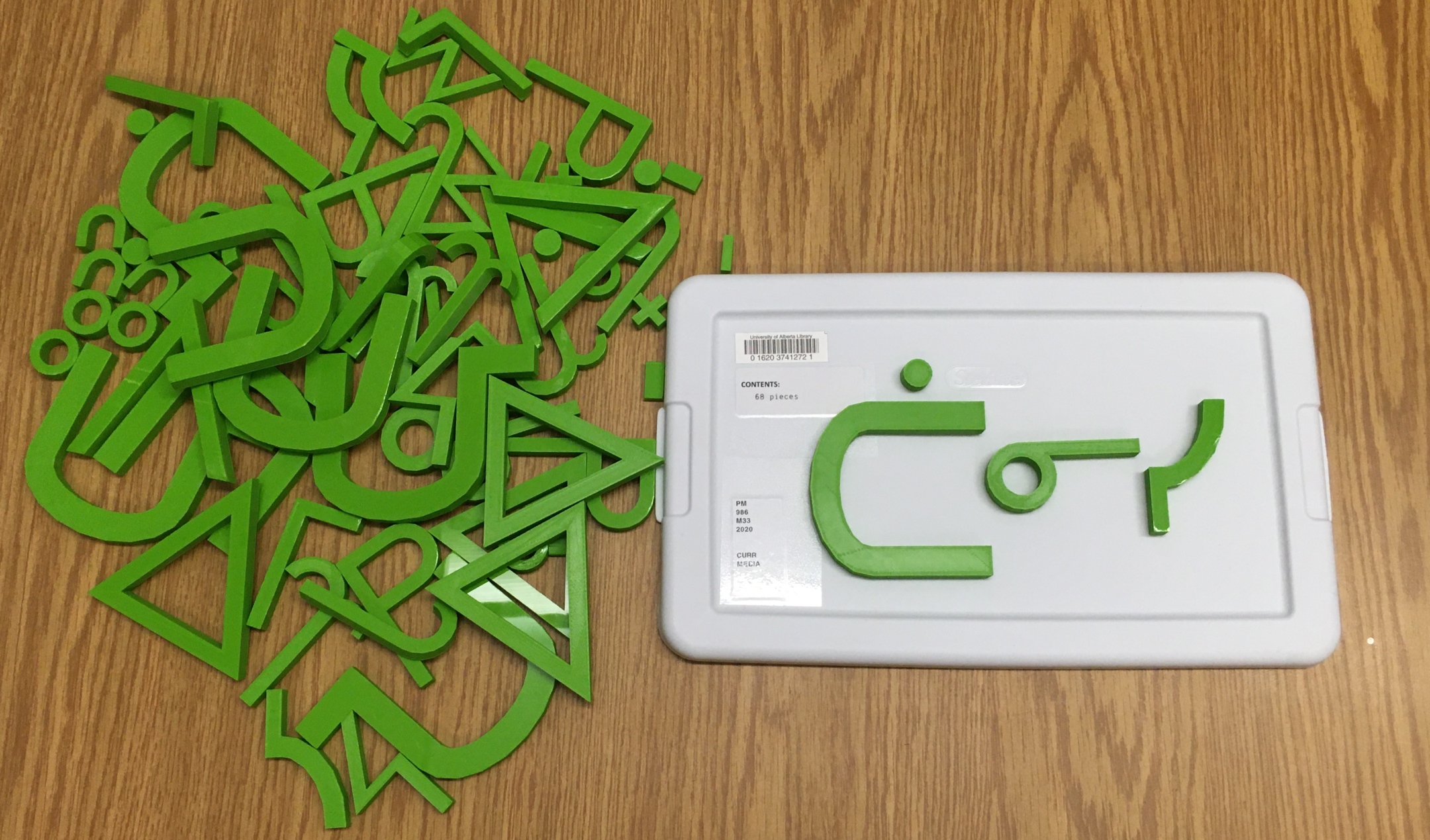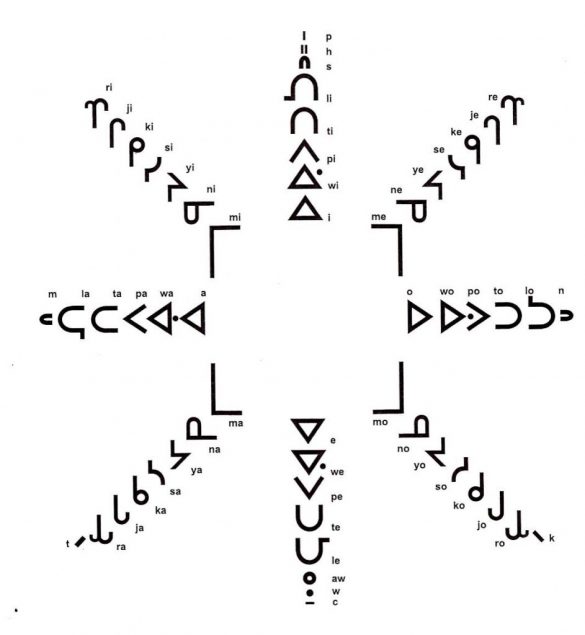Indigenous Intern at Canada’s University of Alberta (UofA) Library, Kaia MacLeod, created a 3D printed syllabics kit arranged in a traditional star chart format to help Indigenous language learners connect with the Cree culture. The 23-year-old graduate student and president of the Library and Information Studies Students’ Association (LISSA) was eager to use her role to help make the library a more welcoming space for Indigenous people. Knowing the UofA offers Cree language classes and is home to the Canadian Indigenous Language Learning and Literacy Development Institute (CILLDI), she decided to 3D print a set of Cree syllabics for the library.
In Alberta, and across Canada, the operation of residential schools resulted in the devastation of First Nations, Métis, and Inuit languages and cultures, like the Cree. In a path towards reconciliation, the Ministry of Education of Alberta has worked with Indigenous stakeholders to ensure opportunities are available to practice and revitalize languages and cultural traditions and customs. Reviving the Cree language involved local communities creating language-learning programs and services to keep Cree alive and flourishing. As a result, the number of Cree speakers has increased along with a population rise over the past 20 years, but more efforts are needed to keep one of the most widely used native languages in North America from phasing down.
 The 64 pieces in Kaia MacLeod’s syllabics kit can be arranged to spell out Cree words like “Tansi” (pictured), which means “Hello.” Image courtesy of Junelle Mah/University of Alberta
The 64 pieces in Kaia MacLeod’s syllabics kit can be arranged to spell out Cree words like “Tansi” (pictured), which means “Hello.” Image courtesy of Junelle Mah/University of AlbertaMacLeod, who gets to work on several Indigenous themed projects as part of her work, knew her older sister and fellow librarian, Lorisia MacLeod, had created 3D printed Cree syllabic files while working as an Instruction Librarian at NorQuest College and had put those files up on the design community Thingiverse. So making a copy for the UofA Library collection was straightforward, although not without a few challenges. In her blog post, MacLeod described that after taking the files to the Digital Scholarship Centre (DSC)’s makerspace to use their 3D printers, she had an adhesion failure, breaks in the PLP, blockage in the print, and more. When it came to the logistics of printing the syllabics, MacLeod decided to use Ultimaker 3D printers for a more detailed job and chose a green color that resembles the UofA’s official green and gold color scheme.
The result is beautiful, the “Cree Syllabics Project” is a symmetrical arrangement of 44 syllabics that was developed by the late Rosanna Houle in the early 1970s and is used by many language teachers today. The kit is made up of 64 pieces, and can help language learners to see how the syllabics are spelled, said MacLeod. The kit was printed-out to reflect the so-called Cree star chart system – also known as Nehiyaw Cahkipenhikanah – a traditional format that incorporates the cultural and philosophical teachings of the Cree language. The star chart also means that users could apply this set to build in various teachings: Cree words, direction teachings, star chart teachings, and more.
“It’s kind of like a stepping stone,” said MacLeod of her innovative 3D printed Cree language resource. For people that are just learning how to write words out in syllabics, it becomes a useful tool to actually see exactly what the syllabic arrangement looks like. She also explained that it will also be helpful for people who are learning Cree pronunciation: “once you know the pronunciation of certain syllabics when it’s laid out in the Star Chart, certain directions will have the same sound.”
 The Cree syllabic star chart. Image courtesy of Kaia MacLeod
The Cree syllabic star chart. Image courtesy of Kaia MacLeodUltimately, MacLeod hopes the Cree classes and the CILLDI program can use the kit and hopes they will need to print more in the future.
“Personally, the importance of having Cree syllabics in the library is meaningful. As a Cree woman, it is great to see my language in a place of learning. Working as a book shelver in the University of Alberta Library I saw the variety of language learning items for different Indigenous languages. It is with a great sense of pride that I can introduce something that connects with my culture,” MacLeod noted.
Since writing about the kit in a UofA blog post in June 2020, MacLeod said that she has had a number of inquiries, including from people in the United States, proving there is a wide interest in increasing Indigenous language resources. The files are freely available on Thingiverse and can be download here. Additionally, MacLeod’s sister sells complete pre-printed sets for $60 through her Twitter account for anyone who doesn’t have access to a 3D printer.
Subscribe to Our Email Newsletter
Stay up-to-date on all the latest news from the 3D printing industry and receive information and offers from third party vendors.
You May Also Like
Gorilla Sports GE’s First 3D Printed Titanium Cast
How do you help a gorilla with a broken arm? Sounds like the start of a bad joke a zookeeper might tell, but it’s an actual dilemma recently faced by...
Nylon 3D Printed Parts Made More Functional with Coatings & Colors
Parts 3D printed from polyamide (PA, Nylon) 12 using powder bed fusion (PBF) are a mainstay in the additive manufacturing (AM) industry. While post-finishing processes have improved the porosity of...
$25M to Back Sintavia’s Largest Expansion of Metal 3D Printing Capacity Since 2019
Sintavia, the digital manufacturing company specializing in mission-critical parts for strategic sectors, announced a $25 million investment to increase its production capacity, the largest expansion to its operations since 2019....
Velo3D Initiates Public Offering in a Bid to Strengthen Financial Foundations and Drive Future Growth
Velo3D (NYSE: VLD) has been among a number of publicly traded 3D printing firms that have attempted to weather the current macroeconomic climate. After posting a challenging financial report for 2023,...































